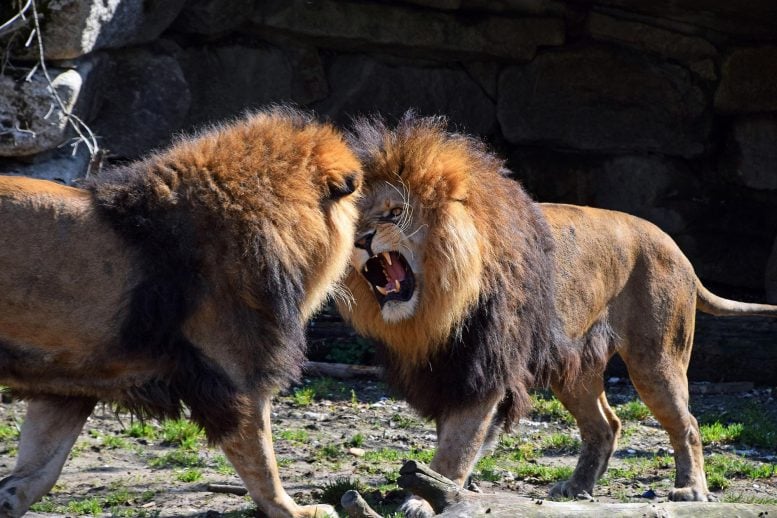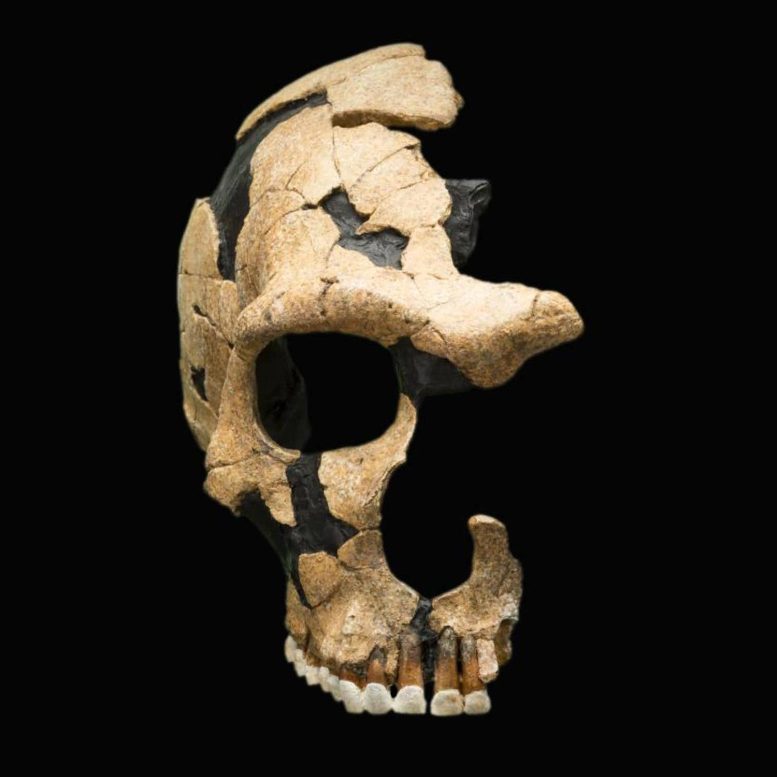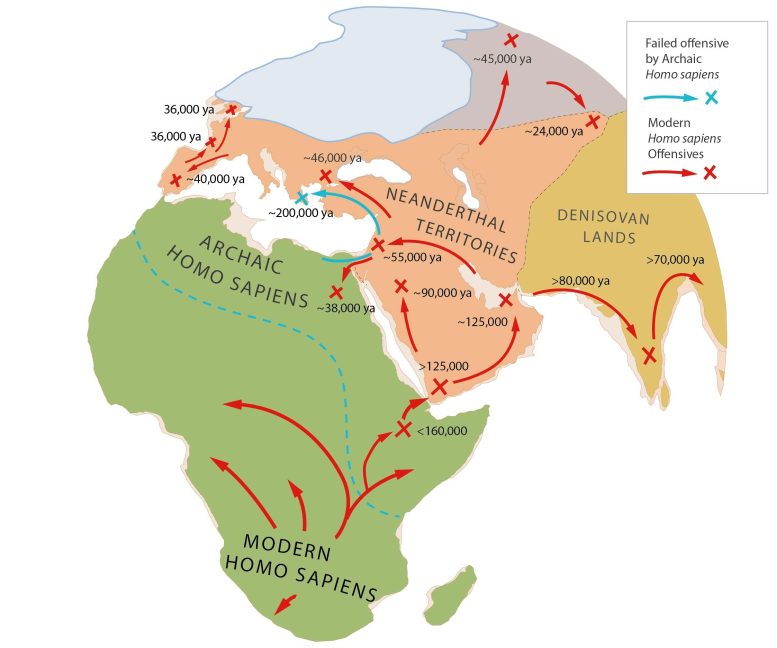
Around 600,000 years ago, humanity split in two. One group stayed in Africa, evolving into us. The other struck out overland, into Asia, then Europe, becoming Homo neanderthalensis – the Neanderthals. They weren’t our ancestors, but a sister species, evolving in parallel.
Neanderthals fascinate us because of what they tell us about ourselves – who we were, and who we might have become. It’s tempting to see them in idyllic terms, living peacefully with nature and each other, like Adam and Eve in the Garden. If so, maybe humanity’s ills – especially our territoriality, violence, wars – aren’t innate, but modern inventions.
Biology and paleontology paint a darker picture. Far from peaceful, Neanderthals were likely skilled fighters and dangerous warriors, rivaled only by modern humans.
Top Predators
Predatory land mammals are territorial, especially pack-hunters. Like lions, wolves, and Homo sapiens, Neanderthals were cooperative big-game hunters. These predators, sitting atop the food chain, have few predators of their own, so overpopulation drives conflict over hunting grounds. Neanderthals faced the same problem; if other species didn’t control their numbers, conflict would have.

This territoriality has deep roots in humans. Territorial conflicts are also intense in our closest relatives, chimpanzees. Male chimps routinely gang up to attack and kill males from rival bands, a behavior strikingly like human warfare. This implies that cooperative aggression evolved in the common ancestor of chimps and ourselves, 7 million years ago. If so, Neanderthals will have inherited these same tendencies towards cooperative aggression.
All Too Human
Warfare is an intrinsic part of being human. War isn’t a modern invention, but an ancient, fundamental part of our humanity. Historically, all peoples warred. Our oldest writings are filled with war stories. Archaeology reveals ancient fortresses and battles, and sites of prehistoric massacres going back millennia.
To war is human – and Neanderthals were very like us. We’re remarkably similar in our skull and skeletal anatomy, and share 99.7% of our DNA. Behaviorally, Neanderthals were astonishingly like us. They made fire, buried their dead, fashioned jewelry from seashells and animal teeth, made artwork and stone shrines. If Neanderthals shared so many of our creative instincts, they probably shared many of our destructive instincts, too.

Violent Lives
The archaeological record confirms Neanderthal lives were anything but peaceful.
Neanderthalensis were skilled big game hunters, using spears to take down deer, ibex, elk, bison, even rhinos and mammoths. It defies belief to think they would have hesitated to use these weapons if their families and lands were threatened. Archaeology suggests such conflicts were commonplace.
Prehistoric warfare leaves telltale signs. A club to the head is an efficient way to kill – clubs are fast, powerful, precise weapons – so prehistoric Homo sapiens frequently show trauma to the skull. So too do Neanderthals.

Another sign of warfare is the parry fracture, a break to the lower arm caused by warding off blows. Neanderthals also show a lot of broken arms. At least one Neanderthal, from Shanidar Cave in Iraq, was impaled by a spear to the chest. Trauma was especially common in young Neanderthal males, as were deaths. Some injuries could have been sustained in hunting, but the patterns match those predicted for a people engaged in intertribal warfare- small-scale but intense, prolonged conflict, wars dominated by guerrilla-style raids and ambushes, with rarer battles.
The Neanderthal Resistance
War leaves a subtler mark in the form of territorial boundaries. The best evidence that Neanderthals not only fought but excelled at war, is that they met us and weren’t immediately overrun. Instead, for around 100,000 years, Neanderthals resisted modern human expansion.

Why else would we take so long to leave Africa? Not because the environment was hostile but because Neanderthals were already thriving in Europe and Asia.
It’s exceedingly unlikely that modern humans met the Neanderthals and decided to just live and let live. If nothing else, population growth inevitably forces humans to acquire more land, to ensure sufficient territory to hunt and forage food for their children. But an aggressive military strategy is also a good evolutionary strategy.

Instead, for thousands of years, we must have tested their fighters, and for thousands of years, we kept losing. In weapons, tactics, strategy, we were fairly evenly matched.
Neanderthals probably had tactical and strategic advantages. They’d occupied the Middle East for millennia, doubtless gaining intimate knowledge of the terrain, the seasons, how to live off the native plants and animals. In battle, their massive, muscular builds must have made them devastating fighters in close-quarters combat. Their huge eyes likely gave Neanderthals superior low-light vision, letting them maneuver in the dark for ambushes and dawn raids.
Sapiens Victorious
Finally, the stalemate broke, and the tide shifted. We don’t know why. It’s possible the invention of superior ranged weapons – bows, spear-throwers, throwing clubs – let lightly-built Homo sapiens harass the stocky Neanderthals from a distance using hit-and-run tactics. Or perhaps better hunting and gathering techniques let sapiens feed bigger tribes, creating numerical superiority in battle.

Even after primitive Homo sapiens broke out of Africa 200,000 years ago, it took over 150,000 years to conquer Neanderthal lands. In Israel and Greece, archaic Homo sapiens took ground only to fall back against Neanderthal counteroffensives, before a final offensive by modern Homo sapiens, starting 125,000 years ago, eliminated them.
This wasn’t a blitzkrieg, as one would expect if Neanderthals were either pacifists or inferior warriors, but a long war of attrition. Ultimately, we won. But this wasn’t because they were less inclined to fight. In the end, we likely just became better at war than they were.
Written by Nicholas R. Longrich, Senior Lecturer in Evolutionary Biology and Paleontology, University of Bath.
This article was first published in The Conversation.![]()
Never miss a breakthrough: Join the SciTechDaily newsletter.
17 Comments
Anyone who says that human migration is a right…. You better look at history and bring an army at your back if you try.
Brush your teeth. Call your Mom. Tell her what you said.
Neanderthal calorie requiremnts were much higher than Sapiens. AS much as 2000 kcal more. This fact alone, along whith climate changes, would doom most of the Neanderthal genome to oblivion.
Additional : Germs.
Those guys have their dieases, and we have ours. Ours ar sort of a pain to us, but deadly to them. Theirs work the same way, the other way. This adds to the defense value of the narrow point of contact. A penetration will be met, with lethal disease, in a small area that will not bring the pathogen into the larger arena.
Natural barrier, lethal, usually invisible. It’s a part of this narrative.
The weakness in the argument, and what is typically ignored in the field in general, is the presence of ancient megalith ruins, which could NOT have been constructed were people warring. Considering the population, the technology, the amount of time and work it would take to quarry, shape, move and stack the huge stones, the evidence suggests a peaceful culture. But then, much later, something changed.
New York was not constructed in a time of peace and tranquility. As for London………..?
Did an academic really write this article, or was it his 12-year-old Homo sapiens bully son?
The article seems to have taken a sensational perspective on a fairly ambiguous area of discussion. Though there is evidence of skirmishes. I do not believe it can be attributed to clashes between Neanderthal and homo sapien. As likely are skirmishes between groups of the same species (or subspecies as some papers now suggest).
The issue of interbreeding & caloric requirements is highly impactful. With higher caloric intake likely implies a larger range. And therefore also lower population density.
As it is clear the species could interbreed, as territory overlap occurred there would be two outcomes. First, Neanderthals would find it increasingly difficult to sustain population as the homo sapiens, who could manage on fewer calories. Combine this with interbreeding between a higher density population and a lower density population, and the one simply, slowly fades out.
The nuances of each species (or again sub-species) adaptations I would argue led to a slow incorporation of the lower population species into the other.
Rape is an intrinsic practice of war, and that includes tribal wars in Papua New Guinea. So evidence for interbreeding is not at all surprising.
It never ceases to amaze me the absolute liberty of narrative taken by some writers that proclaim it to be nonfiction,& with a straight face to boot.
The climate began to deteriorate at about 40k bp. But the now former Neanderthal refugium, in the Levant and southern Spain, was now occupied by growing populations of modern humans. The Neanderthals ran into a brick wall of humanity. You would expect to find a higher number of hybrid modern human/Neanderthals at their ranges interface, in the Levant, toward the end of the Neanderthals existence – which is the case.
..ran into a brick wall of humanity.
More likely a brick wall of inhumanity, to judge by my fellow H saps formerly of Nazi Germany and now modern Israel.
“Male chimps routinely gang up to attack and kill males from rival bands.” This is incorrect. The behavior was not “routine”.
Male chimps, excluding the bonobo chimp, live a very violent life, in sharp contrast to gorillas. After age 15, males become very aggressive and violent to females in particular. Read some of Jane Goodall ‘s studies where she discovered a very dark side to chimp behavior and saw many disturbing traits matching our own. The bonobos have a matriarchal society, led by an alpha female. Whether this feature strongly influences their aggressive behavior is not yet known as numbers of this type of ape, who developed their own culture south of the Congo River, are now so decimated through poaching and the bushmeat trade that came out of the mining of lithium and other minerals used in the manufacture of cell phones. On the other hand, a single Silverback gorilla will guard his family of a small harem of females and young to the point of death. Everyone remembers Digit who gave his life protecting his family. They frequently stop fights, usually over food, among the females in the troop.
There It was just looking straight back at me with out any kind of expression the snare that came from the look was as evil as evil can for only knows evil ..
Survival depends on acceptance and happiness. In life as well as death these choices are discovered daily. The living dilemma is a distortion of time. Awareness consciousness lifespan are all irrelevant to history. It’s the individual who only perceives this moment. Man is not meant to be alone.
If all that is true; well, thank god for the obvious soon to come extinction of our own species; I’ve closely observed both the rat and cockroach species; they’re much better people than us. It’s not as though as if we couldn’t do ourselves better, but the overwhelming joy of killing is an addition that we apparently, would much rather die, than to ever give it up; rather much of a waste of intelligent; but the other two species I mentioned, appear to be significantly more intelligent than us, so we should just step aside and let someone better, take over.